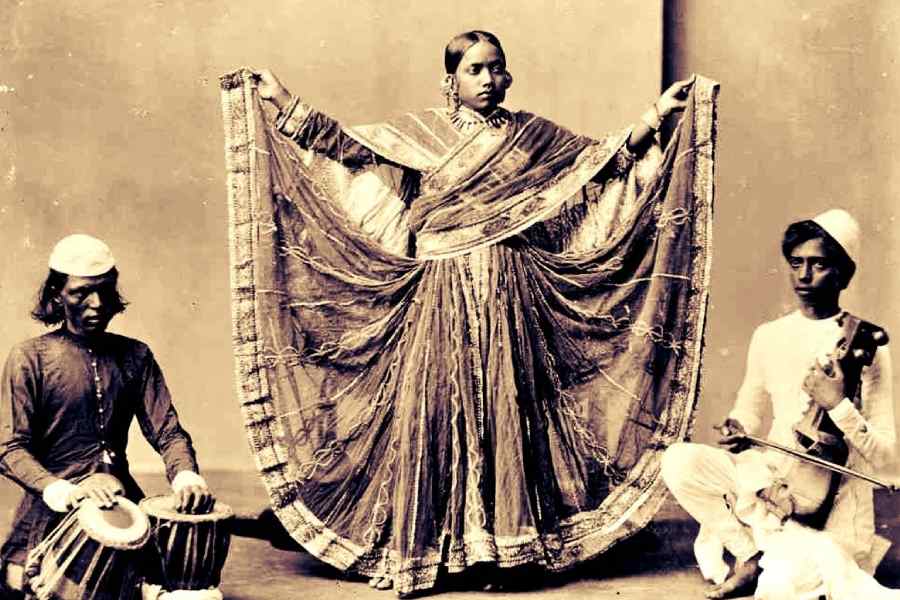DANCE TO FREEDOM: FROM GHUNGROOS TO GUNPOWDER
By A.K Gandhi
Fingerprint, Rs 599
The forbidden is also the worthiest of exploration. A.K. Gandhi’s book is more a corrective literary pursuit than the outcome of a curious mind. The historical distortion, or perhaps manipulation, of what a courtesan’s life entailed and what her identity symbolised for a sophisticated society fuels the author’s intent to bring the nautch girls from the margins of historical apathy, disservice, ignominy, social censure, and patriarchal exploitation to mainstream discussions surrounding their crucial role in scripting India’s independence from colonial rule. Gandhi explains his objective in the Preface in clear terms: whatever has been pruned, forgotten or deliberately erased shall be highlighted by documenting the stories of tawaifs through the lens of ‘soft’ history without entirely abandoning ‘hard’, factual knowledge and official historical accounts.
The five women whose personal histories make up this book are: Azizan Bai, Husna Bai (picture), Begum Samru, Begum Hazrat Mahal, and Dharman Bibi. These women were more than just singing-dancing dolls. The performative art was a weapon of activism that each of them used to restore her dignity and regain socio-political currency. They were highly revered poets and political advisers in royal courts where their decision-making skills and opinions on official matters were considered worthy of attention and implementation. As patriots, they knew when to switch to the roles of warriors and rebels against the foreign masters. Therefore, it is a colossal error that their mysterious, ingenious ways of contributing to the national struggle for independence against the British raj have not been accorded the attention they deserve. For instance, the 25-year-old Aziz-un-Nissa (Azizan Bai) was a courtesan of immense repute under the patronage of the nawab of Lucknow. With the decline in the status of Lucknow’s courtesans, Azizan Bai shifted to Kanpur, where she began her work of “gathering intelligence” and, soon, became an able ally as a revolutionary who passed on information to the Indian sepoys preparing for the 1857 uprising. As per historical accounts mentioned in Gandhi’s book, she would be seen on horseback, “in male attire… armed with a brace of pistols” — this was an interesting and powerful transition on her part, from adorning a courtesan’s embellishments to embracing military attire.
The courtesans epitomised grace, etiquette, and intelligence. To be seen in their company was a mark of elitism, exuberance, and high culture. Thus, the disgrace they faced during the colonial period was shocking and unacceptable. In the 1850s, the vengeance and the resistance of the courtesans were met by the wrath of the coloniser. Rendered powerless after being forcefully relocated by the British who confiscated their properties, imposed hefty fines, and implemented harsh laws on marriage and adoption, the courtesan became a sexualised commodity. The male gaze objectified her and she slowly degenerated into a source of male physical gratification.
Husna Bai (or Husna Jaan), the nominated “Chaudharayan of Banaras”, revered as one of the “greatest singers of classical Hindustani music”, did not bat an eyelid when she questioned Mahatma Gandhi on the rationale behind unfairly equating courtesans with prostitutes. Toward the end of 1920, at a rally, she confronts the Mahatma and says, “Mahatma ji, you’ve put all of us in the same category and that’s not right.” It is important to understand how Husna Bai challenges the homogenisation of women and their experiences. She argues that Mahatma Gandhi’s suggestion for the ‘fallen women’ to take up alternative ‘professions’ points to a rather limited understanding of what makes a woman ‘fallen’. She points out how difficult, in fact, impossible, it would be for courtesans to gain access to the career market given the rigid patriarchal norms and gender dynamics in society. For a courtesan to simply take up a ‘career’, a respectable one at that, is fraught with societal censure and objections. She says, “I don’t think they can adopt other careers. We’ll have to think more broadly.”
Dharman Bibi and her sacrifice are seldom acknowledged even by her own people in Arrah, informs Gandhi. Married to the elderly Babu Kunwar Singh, who had inherited heavy debts under the British regime’s new revenue system, Dharman was a woman with a sense of pride and dignity. Known to have resisted the overtures of her clients with physical strength, Dharman refused to succumb to unconditional servitude to imperialist forces. Motherhood was her ultimate desire. Despite legal codes on adoption for tawaifs, Dharman was fearless when she decided to adopt a girl. In the 1840s, for a courtesan to nurse maternal feelings and find assertion through adoption was prohibited territory. Centuries later, women continue to fight for reproductive rights and autonomy over their bodies.











